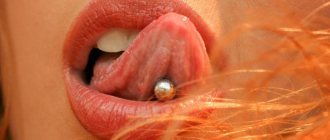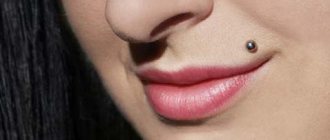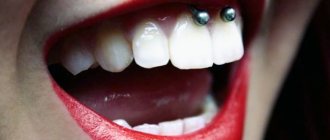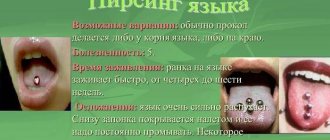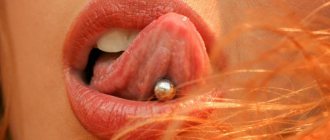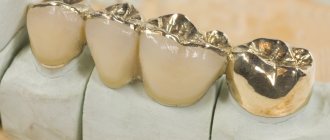Photo from the site: biokrasota.ru
To be completely honest, piercing has become so popular at this time that few of the representatives of modern youth do not have such a bright, but at the same time, not quite ordinary decoration of their own body. The piercing of the genitals or nipples probably causes the most controversy and misunderstanding, but tongue piercing is also a rather controversial issue. Moreover, if the first options are, nevertheless, most suitable for completely extreme types, then tongue piercing is done by many people today, and their reasons for this can be very diverse. It’s worth understanding why people generally do tongue piercing, why they like it, and whether there are contraindications, before making such a rather important decision as piercing.
Types of tongue piercing
There are four types of tongue piercing:
► Vertical - from the frenulum to the palate. Classic and most common puncture.
► Horizontal - the puncture is located on the tip of the tongue, from ear to ear (wide)
► Superficial - the puncture is made across the tongue
► Tongue frenulum piercing – piercing under the tongue
At what age can you get a piercing?
At your own discretion, you can undergo the procedure of installing jewelry from the age of 18. But you can get a piercing earlier – from the age of 14. This will require written permission from parents or guardians.
According to medical data, there is no need to rush into getting a piercing. The growing body of a teenager does not tolerate the introduction of foreign objects well, so it is better to postpone such procedures until adulthood.
Choosing jewelry for piercing
Jewelry for tongue piercing must be made of high-quality material - titanium . Medical steel, gold, silver and other metals contain foreign alloys, which, when in the human body, begin to oxidize, and in the oral cavity this process is much faster, so the consequences after tongue piercing with such jewelry will be very unpleasant. For primary healing, 1.6x22 rods are used (sometimes longer, based on individual measurements of the tongue); a shorter rod can be replaced 2-3 weeks after the puncture. For those who really want a tongue piercing, but have not yet decided, there is a tongue piercing - such jewelry is held on by suction cups or magnets.
What not to do after piercing
- Tugging and removing jewelry: the less you disturb the wound, the faster it will heal. If you remove the barbell in the first 2 months, you will not be able to put it back on your own and will have to go to the piercer again.
- Eating too hot, salty and spicy foods: such foods irritate the mucous membrane, and especially the tender and not yet healed tissue in the piercing area. Particles of solid food can get into a fresh puncture, which in turn can cause an infection. Porridge, yoghurt, etc. are best.
- It is undesirable to smoke, drink alcohol and take blood thinning medications: such drugs dilate blood vessels and the wound takes longer to heal. Nicotine generally suppresses the general immune system, increasing the healing time.
Puncture procedure
First of all, the master helps you choose jewelry. For initial healing, a 1.6x22 bar is placed in a classic tongue piercing; this is a standard size, which, in case of swelling after the piercing, will prevent the jewelry from digging into the tongue. Wraps are selected for the bar depending on the client’s preferences. Next, the master gives the client to rinse his mouth with octenisept and makes markings, looking at the anatomy of the tongue. After this, sterilized instruments are taken out, the tongue is held with a special round clamp and a puncture is made with a piercing needle, with the help of a taper the jewelry is smoothly inserted and the screw is screwed on. After the piercing, your tongue will hurt and swell, but you shouldn’t be afraid of this; the pain will go away quickly if you follow all the recommendations that the master will give you.
What risks exist?
Dental status is the condition of the patient’s oral cavity, assessed on the basis of anamnesis, the results of an external examination, and the intensity of caries. At the end, the KPU index is determined - this is the average number of teeth affected by caries and its complications (K), filled (P) and removed (U). The total sum of these indicators has a certain digital value, namely:
| Index | Patient's oral condition |
| 0 | Healthy people and those who are only at risk. |
| From 1 to 4 | Compensated condition (the resulting defect in the dentition will not subsequently affect the shape and structure of the periodontium). |
| From 5 to 7 | Subcompensated state (intrasystem restructuring occurs in the dentition and periodontium). |
| Over 7 | Decompensated state (intrasystemic restructuring is complemented by inflammatory phenomena in the periodontium and its dystrophy; pathological gingival and bone pockets appear, atrophic processes in the periodontium are observed). |
After the tongue is pierced and the jewelry is installed, a person is considered to be included in the risk group, because now existing problems can worsen at any time and new ones can arise. In addition, few people ask about the health of their teeth before getting a piercing. If such clients at the time of the puncture had, for example, dental caries even at the initial stage (a focus of microorganisms that destroy tooth enamel), an infection in the oral cavity may develop.
Tongue piercing care
In order for the piercing to heal well, you need to know how to care for your tongue piercing. Caring for a tongue piercing includes constant treatment of the oral cavity - Lakalut, Asepta or President rinses ; you need to rinse your mouth 4-5 times a day and after each meal and drink. Swelling after tongue piercing lasts at least 4-5 days, so during this time you will have to refrain from active conversations, hard, spicy and salty foods . If you notice that plaque has appeared after your tongue piercing, you should not try to remove it, as you will injure the piercing. After 2-3 weeks, you can change the barbell to a shorter one (downsize).
Where can I get a piercing?
Despite the simplicity of the procedure, piercing installation should only be performed in a special salon by a qualified piercer. This is the only way to reliably reduce the risk of complications and side effects.
If the procedure is performed incorrectly at home by an unqualified technician, it is almost impossible to ensure sterility. This can lead to infection of the wound by various pathogens, including such dangerous ones as HIV and hepatitis C.
Piercing and gum disease
As we have already written, insufficient hygiene and low-quality metal lead to the development of bacteria. And an excessive amount of bacteria in the mouth leads to gum diseases such as periodontitis.
or
gingivitis
.
The specialists who conducted the study noted tissue degeneration and displacement or loosening of teeth even in very young patients, for whom such diseases were not typical.
Do not play with or remove jewelry
Moving the jewelry can increase pain and irritation and lead to the appearance of new bacteria in the holes.
The only time you should touch it is during cleansing.
It may also be tempting to take out your jewelry, but this may actually do more harm than good.
Removing the jewelry will not only cause additional irritation, but will also allow the new piercing to be covered up. This can trap bacteria and allow the infection to spread beyond the puncture site.
How to pierce your tongue at home
You need to choose a well-lit room so that there is a place to lay out the instrument. Use only disinfected clamp, needle and earring. Wash your hands with soap and wipe with a disinfectant solution. Perform actions wearing disposable sterile gloves:
- Treat your mouth with an antiseptic.
- Choose a puncture site in the middle, closer to the tip of the tongue, there are no large blood vessels there.
- Pinch the tongue with tongs, then use a special needle to pierce it strictly perpendicular to the surface.
- Use a catheter to insert the earring.
- How to detect stomach cancer at an early stage
- How long to cook eggs after boiling water. How to boil a chicken and quail egg hard-boiled, soft-boiled and in a bag
- Shiitake mushrooms: recipes and medicinal properties
Clean the area two to three times daily
Regular cleansing is the best way to get rid of bacteria and prevent further irritation. Morning and night cleaning are ideal. You can also rinse the puncture site with saline solution after each meal.
With pre-prepared saline solution
A ready-made saline solution is the easiest and most effective way to clean any piercing. You can buy them over-the-counter (OTC) at a piercing shop or local pharmacy.
To clean your piercing:
- Dampen a clean cloth or durable paper towel with the solution. Avoid using cotton balls, tissues, or thin towels as they may get caught in the jewelry and cause irritation to the piercing.
- Gently wipe the cloth or towel on each side of the jewelry. Do not rub or touch as this will cause irritation.
- Repeat this process as many times as needed. There should be no crust on the decoration or around the hole.
Contraindications
Absolute restrictions on the intervention:
- age under 18 years;
- pregnancy and lactation period;
- chronic diseases in the acute stage;
- infectious diseases, even a common cold;
- epileptic seizures;
- psychological disorders;
- low blood clotting;
- alcohol and drug intoxication;
- weakened immune system;
- diabetes;
- hemophilia.
Tongue piercing is unacceptable in case of weakened immunity, mental disorders and serious chronic diseases
It is not advisable for anyone under 18 years of age to have their tongue pierced.
How long does it take for a piercing to heal?
After the initial puncture, the wound heals within a few days. Full addiction occurs after 1-2 months. For 2 weeks, slight painful tingling and stretching are felt, but they soon pass.
The puncture heals quickly, but it will take up to 2 months to get used to it
double puncture
Consequences of wearing piercings for the oral cavity in general
Tongue or lip piercing means a permanent hole in the mouth through which harmful microorganisms can circulate. Hard-to-remove food particles can get inside it and onto the earring itself (rings, rods), which gradually rot. Accordingly, bacterial plaque accumulates in this area, provoking various inflammatory processes. Increased plaque accumulation leads to persistent bad breath.
The presence of a ring in the mouth is perceived by the body as a “foreign object,” which causes significant discomfort, especially at the adaptation stage. During a conversation and even chewing food, the jewelry constantly comes into contact with the mucous membranes and causes microtrauma to the delicate tissues.
Piercing in the mouth can have different consequences
Piercing can lead to difficulties with proper chewing of food and impaired diction. Many people experience increased salivation. Some, on the contrary, are concerned about severe dryness and the development of xerostomia. In clinical practice, there are cases when the sensitivity of the punctured muscle organ completely disappears, and as a plus, the taste of food is distorted.
There are also a number of unpleasant, but few expected consequences - allergies, the development of glossitis and even galvanic syndrome. As a rule, jewelry is created from base metals, which tend to gradually oxidize under the influence of the oral environment. As a result, the following reactions are possible: the constant presence of a metallic taste in the mouth, soreness of the muscle organ, swelling, itching and irritation of the mucous membrane, the appearance of a rash (bubbles, pimples, ulcers). As for galvanism, it can develop in people who, in addition to metal piercings, have crowns, dentures and braces in their mouths, which also contain metal.
On a note ! For piercing, barbells or studs are usually used - earrings consisting of a straight rod and several twists (fixing elements). Carefully ensure that the system elements are tightly connected to each other and tighten them periodically. Otherwise, there is a risk of individual elements unwinding, swallowing them, and even suffocation.
Preparing for tongue and frenulum piercing
Before carrying out the procedure in question, you need to approach the choice of a specialist with all seriousness. Banal assurances from a friend or neighbor that they are the “best piercers” are not an indicator. But a person doing a piercing in a beauty salon or beauty salon is quite suitable.
You need to visit a specialist and have a conversation with him. Pay attention to how he answers the questions asked, whether he provides complete/detailed information on the upcoming procedure, and whether he explains all the risks. Be sure to make sure that the procedure is carried out with gloves and only disposable instruments.
You need to choose the decoration in advance, but not only in shape. You definitely need to pay attention to what material the rods, rings, and spirals are made of. The best option would be titanium or medical steel.
“Piercing at home” is nonsense! Even if a good master is found, you should not risk your health and have your tongue or frenulum pierced outside a specialized office. This is due to the fact that it is impossible to comply with all sterility requirements at home.
Immediately before the procedure, the client must eat a hearty meal, since in the next few days he will be forced to remain on a strict diet. Alcohol is strictly contraindicated.
The history of piercing
For the first time, residents of African tribes and Polynesia began to practice the procedure of piercing various parts of the body. The Maasai were the first to introduce various decorations into their ears and lips. At that time, it was believed that the larger the size of the jewelry in the body, the greater the “weight” a person had in the tribe.
Navel piercing first appeared in Egypt. Women loved this procedure very much. The presence of a hole in the navel area of the Egyptian woman indicated that she belonged to “high society.”
In Tsarist Russia, sailors preferred to pierce their earlobes and wear voluminous earrings. Such a “symbol” meant that the person crossed the equator or belonged to the Cossack family. Later, starting in the 80s, it became fashionable for rappers to pierce their earlobes.
Nose piercing first appeared in India. The presence of a septum piercing (a puncture of the nasal septum) in a woman indicated her marital status, that is, that the girl was married.
Nipple piercings were done by warriors of Ancient Rome. An earring in a man's nipple indicated his masculinity, courage and determination. Only the strongest and bravest warriors had the right to have nipple piercings. Those with nipple earrings regularly competed in strength and courage. In order not to damage the “decoration”, special fabric capes were worn over the earrings.
The ancient Aztecs and North American tribes first began piercing their tongues. They carried out the procedure consciously, since it was considered a magical rite that helped to reunite with the Gods. The protruding blood on the tongue was considered sacred; it served as a means of calming the Spirits.
These days, piercings have completely different purposes. By piercing various parts of the body, people want to show their individuality, attract attention or stand out. For some, piercing is a way to feel new emotions, to prove to themselves that they can overcome pain and, as it were, move to a “new level of development.”
Purpose of piercing
People who decide to have their tongue pierced have different goals. It is widely believed that the presence of an earring in the soft tissue of the tongue improves sexual satisfaction in a partner. Young girls often decide to have their tongue pierced simply to become fashionable. Some people pierce a part of their body in order to show others that they belong to a certain subculture.
Tongue piercing helps people stand out “among the crowd,” to indicate that they are not like everyone else, and to prove their own uniqueness and individuality.
Possible complications and consequences
Piercings under the upper lip often heal without complications.
Rarely develop consequences:
- Infection gets into the wound, which leads to suppuration, swelling, and pain at the puncture site.
- Displacement of the earring, its omission due to incorrectly performed piercing.
- Rejection of the material from which the jewelry is made, allergy.
- Damage to tooth enamel, chips.
- Rupture of the frenulum when it is initially thin.
Proper care of the puncture site and avoiding piercing if there are contraindications will help to avoid the development of complications. If after putting on the earring there is discomfort, the frenulum is swollen or bleeding heavily, the jewelry should be removed. After removing the earring, the frenulum heals within a few days without any consequences. The oral mucosa is completely restored after 1.5-2 weeks.
Watch what you eat and drink until it heals completely
What you eat matters, especially if you have a wound in your mouth—in this case, an infected piercing.
Do
As your tongue piercing heals, focus on gentle products that are less likely to get on your jewelry.
It includes:
- ice cream
- mashed potatoes
- yogurt
- oatmeal
Anything chewy may require an extra salt rinse after eating. At this time, you should choose water. Tongue piercing tattoos of the body and face to enlarge individual parts.
Not to do
Extremely crunchy foods, such as chips, can cause additional pain and irritation. You should also avoid pepper, chili powder and other spices.
Alcohol can thin the blood and also damage the cells around the piercing. This may prolong healing time and increase the risk of complications of the body and face to increase certain parts of the beauty salon.
Coffee can also thin the blood. If you don't want to take a temporary break, reduce your usual intake until the infection goes away.
How to pierce the tongue
It is preferable to get your piercing done at a salon as this procedure is considered surgery. In order to choose the right place for a puncture without damaging blood vessels and nerves, the doctor must have the appropriate qualifications. Tools and gloves use disposable or sterilized ones. The sequence of actions is as follows:
- The mouth is pre-treated with an antiseptic; sometimes Lidocaine is used for anesthesia.
- The tongue is grabbed and fixed with a special clamp, then pierced with a needle from the bottom up.
- Finally, jewelry is inserted into the puncture site.
